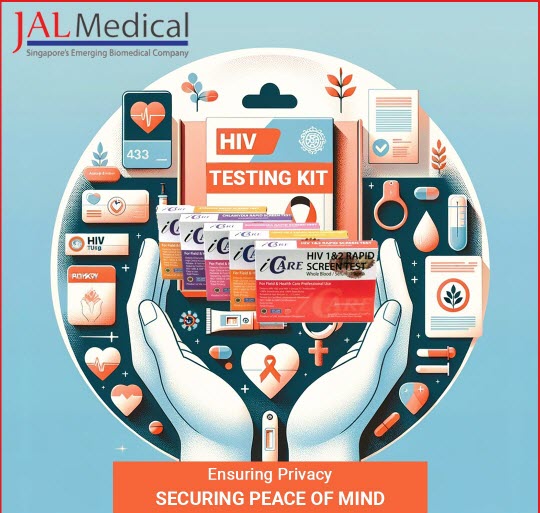Although the prevalence of HIV in Afghanistan is relatively low compared to global figures, the country faces several challenges, including limited awareness and a fragile healthcare infrastructure. Testing and early diagnosis are critical components of the fight against HIV/AIDS and the implementation of effective HIV testing protocols is key to managing and preventing its spread.
This article explores the HIV/AIDS testing protocols in Afghanistan, the role of HIV rapid test kits and how rapid diagnostic tools have responded in the early detection and management efforts in the country.
HIV/AIDS Testing Protocols in Afghanistan
Afghanistan’s healthcare system faces many obstacles, including limited access to diagnostic tools and challenges in reaching remote populations. However, in recent years, many efforts have been made to improve HIV testing services. Below are key elements of HIV testing protocols in Afghanistan:

Voluntary Counselling and Testing Centers
The establishment of VCT centers across Afghanistan is a cornerstone of the country’s HIV testing protocols.
- Voluntary and Confidential Testing: Individuals are encouraged to visit VCT centers for confidential HIV testing. These centers provide pre-test and post-test counseling, ensuring that individuals understand the process and outcomes.
- Access for High-Risk Groups: VCT centers prioritize high-risk groups, including intravenous drug users, sex workers and people in correctional facilities.
Routine Testing for Pregnant Women
HIV testing protocols in Afghanistan emphasize the prevention of mother-to-child transmission.
- Integration with Maternal Health Services: Pregnant women visiting clinics are offered routine HIV testing as part of antenatal care.
- Early Intervention: Identifying HIV-positive mothers early allows for timely antiretroviral therapy, reducing the risk of transmitting the virus to their newborns.
Targeted Testing for At-Risk Populations
Certain groups in Afghanistan are more vulnerable to HIV infection. Testing protocols target these populations to ensure comprehensive coverage such as:
- Injecting Drug Users: Needle-sharing among drug users is a significant contributor to HIV transmission. Mobile testing units and community outreach programs aim to test and educate this group.
- Prison Populations: Incarcerated individuals are screened for HIV to prevent outbreaks in closed environments.
Blood Safety Measures
HIV testing in Afghanistan includes rigorous screening of blood donations to prevent the spread of the virus through transfusions.
- Mandatory Blood Testing: All blood donations are tested for HIV using advanced rapid test kits.
- Standardized Protocols: Blood banks adhere to strict protocols to ensure that the blood supply is safe.

Expansion of Mobile and Community Testing Units
Afghanistan’s rural geography and limited healthcare infrastructure, mobile testing units are integral to reaching underserved areas.
- Community Outreach Programs: These programs use rapid HIV test kits to deliver diagnostic services directly to remote communities.
- Awareness Campaigns: Testing initiatives are often accompanied by public education campaigns to reduce stigma and encourage participation.
HIV Rapid Test Kits Responses in Afghanistan
HIV rapid test kits are a vital tool in Afghanistan’s efforts to diagnose and manage HIV/AIDS. These kits are easy to use, deliver quick results and require minimal training, making them an ideal solution in resource-limited settings.
Accessibility and Ease of Use
Rapid test kits are portable and user-friendly, which is crucial in a country like Afghanistan, where healthcare facilities may be far apart.
- Minimal Infrastructure Requirements: Unlike traditional laboratory tests, rapid kits do not require advanced equipment or facilities.
- On-the-Spot Results: These kits provide results in 15-20 minutes, allowing healthcare workers to counsel and guide patients immediately.
Supporting Widespread Testing
Rapid test kits have been instrumental in expanding the reach of HIV testing in Afghanistan.
- Community-Level Testing: Mobile clinics and outreach programs use these kits to provide diagnostic services in remote areas.
- Testing in High-Risk Population: Rapid test kits are extensively used in prisons, drug rehabilitation centers and other high-risk environments.

Accurate Diagnosis
Modern rapid test kits are highly sensitive and specific, ensuring reliable results.
- Dual Detection: Many kits, such as the HIV Ag Ab test kits, can detect both antigens and antibodies, improving the accuracy of early diagnoses.
- Quality Assurance: Kits from reputable HIV rapid test kit suppliers are tested to meet international standards, ensuring their reliability.
Cost-Effectiveness
Rapid test kits are a cost-effective solution for scaling up HIV testing in resource-constrained settings like Afghanistan.
- Bulk Supply Options: Partnerships with HIV rapid test kit distributors enable healthcare providers to procure kits at affordable rates.
- Reduced Testing Costs: The affordability of rapid kits allows for widespread use in community health programs.
HIV Rapid Test Kit Manufacturers and Suppliers
To ensure the availability of high-quality diagnostic tools, Afghanistan relies on trusted HIV rapid test kit manufacturers and distributors. These suppliers play a crucial role in maintaining a consistent supply of reliable test kits across the country.
- Ensuring Standards: Manufacturers adhere to international guidelines to produce test kits with high sensitivity and specificity.
- Training and Support: Suppliers provide training for healthcare workers on the proper use of test kits, ensuring accurate results.
- Distribution Networks: Collaborations with HIV rapid test distributors ensure that test kits are available even in remote regions.
Future Prospects for HIV Testing in Afghanistan
To overcome these challenges and further improve HIV testing protocols, Afghanistan must:
- Enhance Public Awareness: Education campaigns should focus on reducing stigma and promoting the benefits of early testing.
- Strengthen Partnerships: Collaborating with international organizations and HIV rapid test kit suppliers can ensure a steady supply of high-quality diagnostic tools.
- Integrate Testing with Other Services: Combining HIV testing with tuberculosis and hepatitis screenings can improve efficiency and reduce costs.

Conclusion
HIV/AIDS testing protocols in Afghanistan have made significant strides in improving early detection and management of the disease. The integration of HIV rapid test kits into the healthcare system has been a game-changer, providing quick, reliable and accessible diagnostic solutions. Despite existing challenges, continued efforts to expand testing services, raise awareness and reduce stigma can significantly enhance Afghanistan’s fight against HIV/AIDS. By leveraging the capabilities of rapid test kits and fostering partnerships with reliable manufacturers and distributors, Afghanistan can strengthen its healthcare response and improve public health outcomes.
FAQs on HIV Rapid Test Kit
What is the significance of HIV rapid test kits in Afghanistan?
HIV rapid test kits provide quick, reliable results and are essential for expanding testing coverage, particularly in remote and underserved areas.
How do HIV rapid test kits work?
These kits detect HIV antigens or antibodies in a blood or oral fluid sample, delivering results within 15-20 minutes.
Are HIV rapid test kits accurate?
Yes, modern HIV rapid test kits have high sensitivity and specificity, ensuring accurate results when used correctly.
How can stigma around HIV testing be reduced in Afghanistan?
Public awareness campaigns, community engagement and the availability of private home-testing options can help reduce stigma and encourage more people to get tested.
What are the key challenges in HIV testing in Afghanistan?
Stigma, limited healthcare infrastructure, lack of awareness and funding constraints are some of the primary challenges faced.

